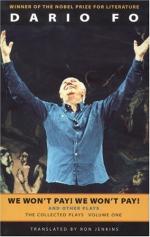|
This section contains 3,941 words (approx. 14 pages at 300 words per page) |

|
SOURCE: "Dario Fo: Zanni and Giullare," in The Commedia Dell'Arte: From the Renaissance to Dario Fo, November, 1988, pp. 315-29.
[In the following essay, Farrell presents Fo as a political revolutionary but a theatrical conservative in that he employs traditional characters and styles dating from the Medieval performers, giullare, to promote his radical politics.]
The affection for, and identification with, figures from Italian theatrical tradition, be it Arlecchino or the giullare, are perfect illustrations of one of the most striking and paradoxical features of the work of Dario Fo—his relentless search for models from the past with whom he can identify. If on the one hand Fo is customarily seen, and indeed goes out of his way to present himself, as the subversive, the iconoclastic revolutionary, the admirer of Marx and Mao, the writer who dramatizes the dilemmas, the struggles, the controversies of today, or as the clown...
|
This section contains 3,941 words (approx. 14 pages at 300 words per page) |

|


